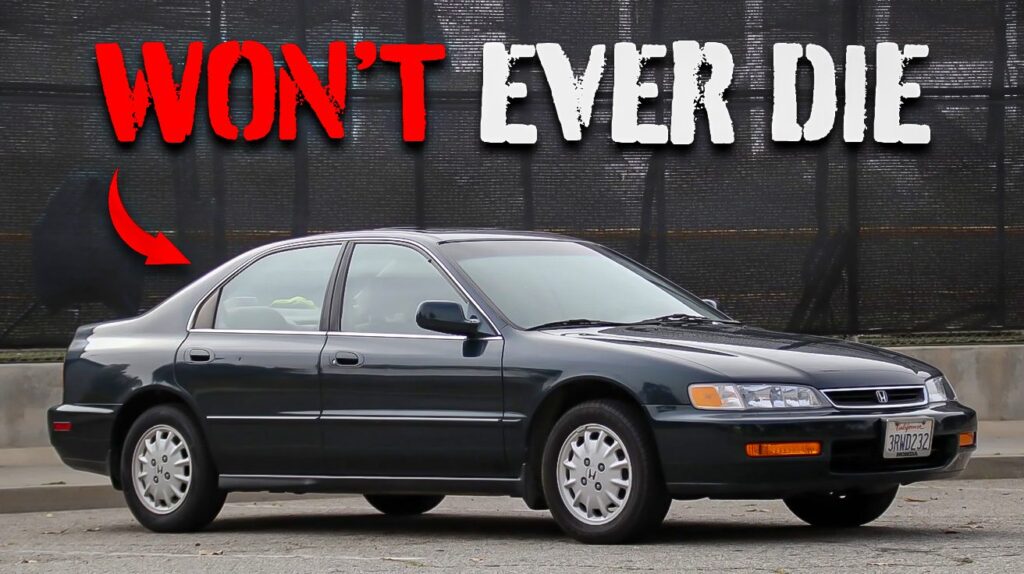
1990s cars aren’t just transportation; they’re time capsules on wheels, often outlasting their predicted lifespans. Back then, manufacturers built rides tough enough to survive Y2K, multiple owners, and questionable maintenance habits. These cars were engineered with a “built to last forever” mentality that’s almost mythical now. From Japanese ingenuity to German overengineering, each pick reflects a commitment to reliability. Buckle up as you explore vehicles tougher than your uncle’s stubborn opinions at Thanksgiving dinner.
10. Volvo 850 (Exterior)

Unlike flimsy modern cars, the Volvo 850, released in 1991, was built like a Swedish tank. Thick metal chassis resisted rust like a Viking facing a rainstorm. Picture this: fighting traffic in a blizzard, knowing your ride’s tougher than a two-day-old meatball sub.
Volvo 850 (Interior)

Available with a naturally aspirated 2.4L 5-cylinder or turbocharged version, the 850’s transmission and suspension were engineered to outlast your questionable life choices. Finding commuter examples cruising past 200,000 miles with just basic maintenance isn’t unusual. While your neighbor’s ride falls apart faster than IKEA furniture, you’ll be chilling with a car that’s basically immortal.
9. Mazda B Series Pickup (Exterior)

Running a landscaping company? You need a truck tougher than your clients’ neglected hedges. Enter the Mazda B Series, a pickup with manual everything, leaf spring suspension that could handle a ton, and a frame so thick it could double as a boat anchor. One operator racked up over 400,000 miles on the original 2.2L 4-cylinder engine with its meager 85 horsepower.
Mazda B Series Pickup (Interior)

Manual transmission and windows might not scream luxury, but who needs those when you’ve got reliability for days? The engines were non-interference, meaning you could snap a timing belt and keep rolling without turning your engine into modern art. If function over flash appeals to you, the B-Series is the automotive equivalent of that trusty Leatherman you can’t live without.
8. Jeep Cherokee XJ (Exterior)

Produced from 1984 to 2001, the Jeep Cherokee XJ wasn’t just an SUV; it defined what a modern SUV should be. This ride came correct with uni-body construction and solid axles front and rear, powered by the trusty 4.0L inline-six engine.
Jeep Cherokee XJ (Interior)

Need a cheap replacement part? The aftermarket had you covered like a bad toupee. Imagine needing a new taillight and finding six options—including one from a guy who swears it fell off a movie set. The XJ’s testament to durability handles bumps like your drunk uncle handles Thanksgiving dinner.
7. Honda Accord (Fourth Generation) (Exterior)

About 380,000 kilometers (236,000 miles)—that’s roughly the distance to the moon, and some fourth-gen Honda Accords could probably make the trip. While other manufacturers were figuring out planned obsolescence, Honda was busy building cars like tanks. The 2.2L F22 4-cylinder and 2.0L F20 engines, smooth manual transmission, and paint job thicker than your grandma’s Christmas cookies meant these Accords were practically immortal.
Honda Accord (Interior)

Unlike rivals that treated rustproofing as optional, Honda used galvanized metal, ensuring the fourth generation was more “forever car” than “future scrapheap.” Cruising down the highway in your Accord, knowing its single overhead cam engine is just hitting its stride, even after a quarter-century and countless commutes. With basic maintenance, you might just outlive your car payments and your therapy bills.
6. Ford F-150 (Ninth Generation) (Exterior)

Anyone who’s tried fixing a new car with a laptop knows the pain of over-engineered complexity. The ninth-generation Ford F-150, built from 1992 to 1996, kept things blessedly simple. Choose from robust engines—a 4.9L inline-six, 5.0L V8, or 5.8L V8—plus the option of a manual transmission, for those who still liked feeling in control. Galvanized bodies meant they didn’t dissolve into rust flakes after a hard winter.
Ford F-150 (Interior)

When it comes to trucks that refuse to quit, this era of the F-150 is like that reliable friend who always shows up to help you move—dependable to the point of being boring, but secretly grateful they’re around.
5. Nissan Maxima (Fourth Generation) (Exterior)

“Four-door sports car” wasn’t just marketing slogan for Nissan’s fourth-gen Maxima, produced from 1995 to 1999. The VQ30DE engine—a 3.0L V6 pushing 190 horsepower and 205 lb-ft of torque—had forged internals tough enough to handle abuse. That’s quality kit more often found in serious performance cars.
Nissan Maxima (Interior)

Got a buddy who treats their ride like a rental? The Maxima’s multi-link rear suspension and thick paint held up better than most. Here’s proof: some owners logged over 340,000 miles on original components, from 2001 to 2018. Even after nearly two decades on the road, it’s like discovering your grandma’s secret stash of lottery tickets—a pleasant surprise.
4. Toyota 4Runner (Second Generation) (Exterior)

When an SUV is basically a pickup truck cosplaying, you know it’s built for business. From 1990 to 1995, the second-generation Toyota 4Runner was basically daring you to try and break it. With a galvanized frame tougher than a two-day-old steak, and thick steel body, it could probably survive a zombie apocalypse better than most marriages.
Toyota 4Runner (Interior)

These rigs packed either a 22RE 4-cylinder or 3VZ-E V6 engine, both about as sophisticated as a hammer. Plus, with solid axle front suspension and removable tops, it’s begging to hit trails rougher than your uncle’s dating life. Some owners have kept these going well into the 2010s, racking up over 450,000 miles on original parts. When it outlasts a mortgage, you know you’ve built a tank.
3. Mercedes-Benz W124 E-Class (Exterior)

Some might call modern car design innovative, but then you see the W124 E-Class, produced from 1985 to 1995, and realize “over-engineered” is the true flex. Thick galvanized steel bodies—tough enough to make a Prius jealous—and multi-link rear suspension that smoothed out potholes before “smooth” became a marketing buzzword.
Mercedes-Benz W124 E-Class (Interior)

You can imagine cruising down the autobahn in a W124, M103 straight-six humming like a well-fed kitten, or maybe the OM602 diesel chugging along—the same ones found in taxis with over 750,000 miles on original components. The W124 wasn’t just a car; it’s a monument to German engineering that proves some things are built to outlast everything.
2. Honda Civic (Fifth Generation) (Exterior)

Civic owners swear that you can set your watch by these little cars. The fifth-generation Honda Civic, built from 1992 to 1995, was engineered with a galvanized body to resist rust, and double wishbone suspension—more than you can say for the flimsy excuses on the road these days. Choose from the economical D15 1.5L or the slightly peppier D16 1.6L engines.
Honda Civic (Interior)

But if you wanted a real party trick, there was the B16 VTEC, because everyone needs a little VTEC in their life. Picture a student in your college parking lot, circa 2002: His ride looks stock, maybe a little sun-baked, but underneath? He’s got a Civic that’s cruised from 150,000 to 400,000 miles and still pulls down 40 MPG. Not bad for a car older than his girlfriend. That’s how legends are born.
1. Toyota Camry (Third Generation) (Exterior)

Camry, like the Kardashians, is famous for reliably being famous. Built from 1992 to 1996, the third-generation Toyota Camry became the default for dependable transport. With a galvanized body, MacPherson struts, and engine choices including a 2.2L 5S-FE 4-cylinder and 3.0L 3VZ-FE V6, the Camry kept running when everything else quit.
Toyota Camry (Interior)

A student with more ramen packets than dollars needs to get to class without becoming a TikTok meme. One owner drove his Camry from new to 485,000 miles on original components—that’s like driving to the moon and halfway back. The secret? Basic maintenance and sensible engineering. This Camry proved it could last longer than most marriages and definitely outlast your college debt.
Last modified: September 15, 2025







